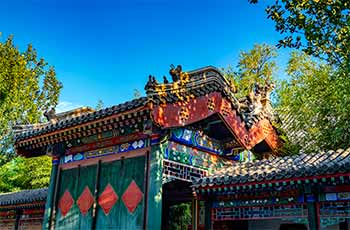Prince Gong’s Mansion

Prince Gong’s Mansion is the princely residence in best preserved in China. The mansion includes more than 30 building groups in various styles, and it is the prince’s mansion with the largest scale in the Qing Dynasty. It was once occupied by He Shen, a famously corrupt official, and later by Yong Lin, Prince Qing of the Qing Court. The mansion earned its name because it was occupied by Yi Xin, who was Prince Gong in the late Qing Dynasty. Prince Gong’s Mansion witnessed the reign of seven emperors, including Qianlong, Jiaqing, Daoguang, Xianfeng, Tongzhi, Guangxu and Xuantong. It existed throughout the course of history from the heyday to the demise of the Qing Dynasty. Therefore, there is a saying that Prince Gong’s Mansion represents half of the history of the Qing Dynasty.
- Chinese Name: 恭王府 Gōng Wáng Fǔ
- Duration: 2-3 hours
- Entrance fee: RMB 40, combined ticket: RMB 70 (including entrance fee, guide service, Prince Mansion Theater, and a performance in the theater)
- Opening Hours:
8:00-17:00, April. 1-October. 31;
9:00-16:00, November. 1-March. 31 - Address: No.17 Qianhaixi Street, Xicheng District, Beijing 100009, China
- Best time to visit: March to May, September to November
- How to get there: You may take buses No.107, 111, 118, 13, 204 Inner Ring, 42, 609, 612 and 623 to get off at the stop of Beihai North Gate, and then visit the attraction.
- Subway lines: You can take subway Line 6, and exit from Gate B (northeast gate) at the station of Beihai North Gate. Path 1: Go forward 200m via Sanzuoqiao Hutong. Path 2: Go forward 200m via Longtoujing Street.
Highlights of Prince Gong’s Mansion
1. Fu Culture (Culture of Blessings)
 a monument engraved with "fu"
a monument engraved with "fu" There are a myriad of dragons in the Forbidden City, while there are a myriad of “fu” characters in Prince Gong’s Mansion. It is said that there are ten thousand bats in the garden of Prince Gong’s Mansion. (In Chinese, a bat is known as a bianfu or simply fu, which shares the same pronunciation with the Chinese character for blessings.) There are 9,999 bats carved on the buildings in the garden. If you then add the “fu” character stele written by Emperor Kangxi, there are ten thousand “fu” characters in the garden in total. Therefore, the garden is also known as Wanfu Garden (Garden of Ten Thousand Blessings).
The fu culture at Prince Gong’s Mansion is a culture of hidden blessings. In Chinese architecture, bats symbolize blessings and good luck. The buildings in Prince Gong Mansion have cleverly borrowed this concept to use the designs of bats for all its buildings. The only visible Fu, as well as the most valuable treasure, is the Stele of Fu Character, written by Kangxi Emperor. It is stored inside the Miyun Cave as “the stele in the cave” means “a blessed paradise” in Chinese.
2. Unique Buildings in the Prince’s Mansion
The length of Prince Gong Mansion from south to north is 330m, and its width from east to west is 180m. In Beijing, there are dozens of prince’s mansions, which were either destroyed or are occupied for some other purpose. The only prince’s mansion conserved with its original appearance is Prince Gong’s Mansion
 the buildings in the Prince's Mansion
the buildings in the Prince's Mansion As an ancient garden for the imperial house of the Qing Dynasty, the prince’s mansion consists of two parts, the residence and the garden. It encompasses an area of more than 60,000 square meters. The area for residential buildings is about 32,000 square meters, and the area of the garden is 28,000 square meters.
The buildings in the mansion consist of three rows: the east, the middle, and the west. From south to north, the buildings are courtyard houses with multiple neat three-chamber structures. In these houses, there are not only buildings with imperial magnificence, but also ones with delicate ornaments from the civil society. Such a combination is the most recognizable characteristic of the prince’s mansion culture.
The garden combines southern landscape garden styles and northern building styles. It includes both western architectural wonders with the Chinese classical garden elements. Prince Gong’s Mansion is one of the typical Qing Dynasty prince’s mansions, and it also represents the traditional Chinese building at its best maturity.
3. Prince Gong’s Mansion and A Dream of Red Mansions
A Dream of Red Mansions by Cao Xueqin is one of the four greatest literary masterpieces in China. Prince Gong’s Mansion has something subtle to do with the Jia Mansion and the Grand View Garden. Over the years, there have been folk stories and heated academic discussions about the topic. In particular, Zhou Ruchang, a prominent scholar who specializes in the studies of A Dream of Red Mansions, argues that Grand View Garden was inspired by Prince Gong’s Mansion, which was occupied by the Caos before He Shen took over. His opinions are of great influence among scholars.
Drop us a line and we'll connect you with the top China expert in no time!